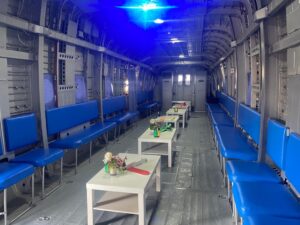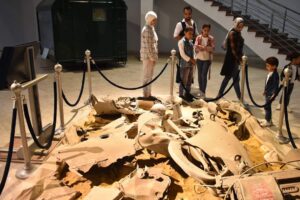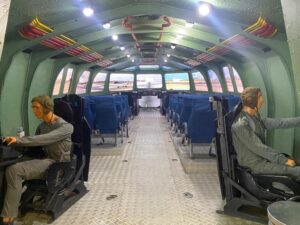President Abdel Fattah El Sisi always said that building human capacities and raising awareness of people about Egypt’s history and unprecedented achievements of the present protect the country from any danger.
His maxim is implemented by the staff of the Egyptian Air Force Museum. It is not just an edifice for displaying the heritage of the Egyptian Air Force. It also plays a role in deepening the concept of belonging among Egyptians whatever their age.
“The museum is not just a specified museum for the air force and its glorious history, but we add an outer frame of targeting people whatever their different hobbies to increase their loyalty and belonging through activities suitable for their age,” museum director Air Vice Marshal Magdy Alsayed Dwidar told the Egyptian Mail.
He added that wars have recently put aside the use of armed force, and have become highly dependent on soft power because it is the most influential, most widespread, longest-lived, and least costly in hegemony and control over the other.
“Soft power attracts youth and tries to strip them of their loyalty and their identity, and some feel that they have no role in their homeland, while others are being recruited for destructive actions against the country. It is more lethal than hard power,” Dwidar said.
He added that museum staff work to contribute to the cultural and social development of society through the dissemination of knowledge and national awareness by holding events, sponsoring various initiatives, social and humanitarian activities, and organising celebrations on all occasions as a tool for expressing national identity, and instilling it among successive generations in a soft way that infiltrates them through these tools.
Among the activities was an exhibition ‘Made in Egypt’ in which many exhibitors participated and displayed their Egyptian-made products.
“Most visitors may come especially for them to buy their products. So we take this opportunity to let them tour the museum to be connected to the history of their homeland,” Dwidar said.
Another celebration was held to celebrate World Women’s Day, during which the museum staff displayed a film on women’s achievements.
Tours start hourly at 10 a.m. until 3 p.m. with male or female guides around the outdoor display passing a circular display of 27 fixed wing aircrafts and helicopters. At the centre stands a TU-16 bomber.
Visitors can actually go inside an MI-6 helicopter which has been recently redesigned for educational purposes. Inside the aircraft, visitors can watch scientific experiments and documentaries on aviation.

The tour inside the building itself is another world. The ceiling is full of clouds as if the visitors fly in an aircraft.
The lobby displays a small wooden model of a plane dating back to 2,000 BC. It was found in a tomb in 1892 in Saqqara. Experts said that it is a model of a sailplane.

On this floor is a 100-seat cinema showing films about 6 October 1973 and recent anti-terror operations.
“Many countries are vying to conduct joint air training exercises with the Egyptian air force. All these must be seen by young people, so we show films about these training exercises,” Dwidar said.
The museum library contains books on the Egyptian Air Force and is an important source in the field of military sciences.
A mural tells the history of aviation in the world and the Egyptian Air Force with the first three Egyptian pilots is on display. The Egyptian Army Air Service was formed in 1932, and became an independent air force in 1937. It also shows the first Tiger Moth biplane to enter service and the first flight from England to Almaza Airport with planes piloted by Egyptian pilots in 1932.

On display is the wreckage of an Israeli F-4 plane among many of the aircraft that the Egyptian Air forces destroyed in the October 14, 1973 air battle near the town of el-Mansoura, in the Nile Delta. This 53-minute battle is regarded by many experts as the longest and largest battle in history.
To commemorate the Air Force Martyrs’, the museum dedicated a hall for them featuring photos of most of them starting from those who died in 1948 until today.
An interesting experience is riding in a simulator of the TU-16 plane, taking off from Almaza Airport, in which the visitor can see Egypt’s tourist attractions through the plane’s windows.

The upper floor includes a puppet theatre, where children can learn about the museum and October victory.
On this floor workshops for children are held. They can colour pictures of aircraft, make jigsaw puzzles of aircraft, and make aircraft models.
“Before holding exhibitions for children, we invite people who participated in October 1973 to narrate to them the great war and our victory. Like we do with all visitors, we show them a film about the war and a puppet show tackling the same topic in a simple way. After that we asked them to draw what they felt. The result was much higher than we expected,” Dwidar said.
“I remember a 6-year-old girl saying that she is so happy and proud of those great soldiers who lost their lives to bring this great victory,” he said. “She talked with pride about the war, of which we celebrated the 48th anniversary last month. It is really another victory,” he said.
The Egyptian Air Force Museum is in El-Orouba St, Heliopolis. It is open daily (except Tuesdays) from 9am-3pm.






Discussion about this post